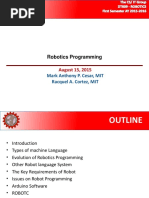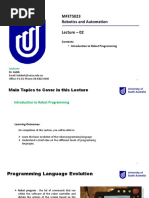0 ratings0% found this document useful (0 votes)
17 viewsUnit 3 Programming Language
Introduction to programming
Uploaded by
sunilramteke49Copyright
© © All Rights Reserved
Available Formats
Download as PPTX, PDF, TXT or read online on Scribd
0 ratings0% found this document useful (0 votes)
17 viewsUnit 3 Programming Language
Introduction to programming
Uploaded by
sunilramteke49Copyright
© © All Rights Reserved
Available Formats
Download as PPTX, PDF, TXT or read online on Scribd
You are on page 1/ 9
The textual robot Language
First textual robot language was WAVE, developed in 1973 as an
experimental language for research at the Stanford artificial
intelligence laboratory.
Development of subsequent language began in 1974 at Stanford.
The language are called AL and it could be used to control
multiple arms in task requiring arm coordination.
Many of concept of WAVE and AL went into the development of
the first commercially available robot textual language, VAL( for
Victor’s assembly language, after victor scheinman). VAL was
introduced in 1979 by unimation, Inc., for its puma robot series.
This language was upgraded to VAL II and released in 1984.
Work in robot language development was also taking place at the T.J.
Watson research lab of IBM corporation, starting at 1976. two of the
IBM language were AUTOPASS and AML (a manufacturing language),
the second of which has been commercially available since 1982 with
IBM’s robotic product. Both of these languages are directed at
assembly and related tasks.
Some of other textual languages for robots that should be mentioned
include RAIL, introduced in 1981 by automatrix for robotic assembly
and arc welding as well as machine vision; MCL ( Manufacturing
control language); developed under U.S. air force sponsorship by
McDonnell-Douglas as an enhancement of APT (Automatically
program tooling) numerical control part programming language; and
HELP, available from General electric company under license from
Italian firm DEA
Generation of robot programming
language
The textual robot languages possess a variety of structures and
capabilities. These language are still evolving. In this section we see
the two generation of textual language.
First Generation Language- The first generation language use a
combination of command statement and teach pedant procedure for
developing robot program. They were developed largely to implement
motion control with textual programming language and are therefore
sometimes referred to as motion level language. typical feature
include the ability to define manipulator motion (using the statement
to define the sequence of motion and teach pedant to define the
point location), straight line interpolation, branching and elementary
sensor command involving binary (On-off) signal. They can be used to
define motion sequence of manipulator (MOVE), they have
input/output capabilities (WAIT, SIGNAL) and they can be used to
write
Subroutine (BRANCH). The VAL language is an example of First
generation robot programming language.
Common limitation of first generation language include inability to
specify complex arithmetic computations for use during program
execution, the inability to make use of complex sensors and sensors
data and limited capacity to communicate with other computer.
Second generation language
Second generation languages overcome many of the limitation of the
first generation languages and add to their capabilities by incarporating
features that make the robot seem more intelligent.this eneble the robot
to accomplish more complex task. commercially available second
generation languages include AML, RAIL, MCL and VAL II. Programming in
these languages is very much like computer programming. this might be
considered disadvantage sience computer programming skill are
required to accomplish the programming. the second generation
languages commanly make use of teach pedant to define location in the
work space.
the features and capabilities of these second generation languages can
be listed as follows
1. Motion control- this feature is basically the same as for first
generation languages
2. Advanced sensor Capabilities- the enhancement in second
generation languages typically include the capacity to deal with more
than simple binary (On-off) signal, and the capability to control
devices by means of the sensory data.
3. Limited intelligence- This is the ability to utilize information
received about the work environment to modify system behaviour in
a programmed manner.
4. Communication and data processing- Second generation
language generally have provisions for interacting with computers
and computer data bases for the purpose of keeping records,
generating reports and controlling activities in the work cell
You might also like
- Generation of Robot Programming LanguagesNo ratings yetGeneration of Robot Programming Languages2 pages
- Unlike Computer Programming in Robotics There Is No One CommonNo ratings yetUnlike Computer Programming in Robotics There Is No One Common4 pages
- VMKV Engineering College, Salem Aeronautical Engineering CourseNo ratings yetVMKV Engineering College, Salem Aeronautical Engineering Course12 pages
- ELX 321 MODULE 4 Roboicst Kinematics and ProgrammingNo ratings yetELX 321 MODULE 4 Roboicst Kinematics and Programming10 pages
- Robot Programming: Amirkabir University of Technology Computer Engineering & Information Technology DepartmentNo ratings yetRobot Programming: Amirkabir University of Technology Computer Engineering & Information Technology Department35 pages
- Robot Programming - From Simple Moves To Complex Robot TasksNo ratings yetRobot Programming - From Simple Moves To Complex Robot Tasks16 pages
- C Programming: C Programming Language for beginners, teaching you how to learn to code in C fast!From EverandC Programming: C Programming Language for beginners, teaching you how to learn to code in C fast!No ratings yet
- Robot Programming Languages (1) .PDF - 20240426 - 121925 - 0000No ratings yetRobot Programming Languages (1) .PDF - 20240426 - 121925 - 000010 pages
- New Learning of Python by Practical Innovation and TechnologyFrom EverandNew Learning of Python by Practical Innovation and TechnologyNo ratings yet
- Robot Manipulators Mathematics, Programming & CoNo ratings yetRobot Manipulators Mathematics, Programming & Co18 pages
- Module VI- ROS and Programming of Robots-updatedNo ratings yetModule VI- ROS and Programming of Robots-updated133 pages
- The New Robotic Era: 1.1 Historical Development and Future of RoboticsNo ratings yetThe New Robotic Era: 1.1 Historical Development and Future of Robotics33 pages
- Unit IV Robot Kinematics AND Robot Programming: Prepared byNo ratings yetUnit IV Robot Kinematics AND Robot Programming: Prepared by21 pages
- EC368 Robotics MODEL QUESTION PAPER WITH DETAILED ANSWER KEY100% (2)EC368 Robotics MODEL QUESTION PAPER WITH DETAILED ANSWER KEY21 pages
- COMPUTER PROGRAMMING FOR KIDS: An Easy Step-by-Step Guide For Young Programmers To Learn Coding Skills (2022 Crash Course for Newbies)From EverandCOMPUTER PROGRAMMING FOR KIDS: An Easy Step-by-Step Guide For Young Programmers To Learn Coding Skills (2022 Crash Course for Newbies)No ratings yet
- Robotics Through the Decades By: Prishu GaireNo ratings yetRobotics Through the Decades By: Prishu Gaire5 pages
- Robotics: 3 Pillars of Robotics 1) SenseNo ratings yetRobotics: 3 Pillars of Robotics 1) Sense12 pages



































































